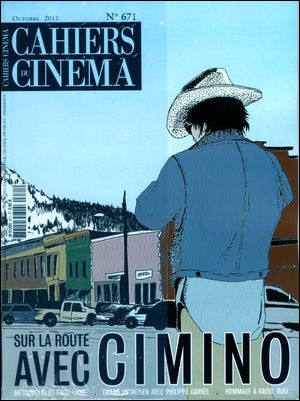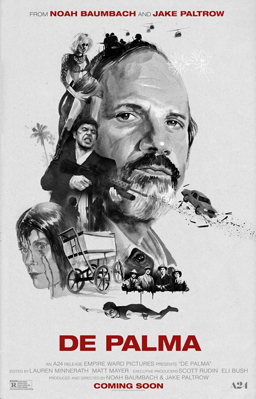In 1976, the first time I saw “Carrie,” it was the most dramatic film experience of my life. The movie had the kind of impact on me that other people experienced with “The Exorcist” or “Jaws” — it made my head swivel around with fear and excitement, with the sheer cinematic fairy-tale pleasure of what I was seeing, and I lived inside the experience for months. It took over my very being. I, of course, went back and read the Stephen King novel on which “Carrie” was based, and saw that the film followed the book reasonably closely. Yet in no way did that detract, for me, from De Palma’s achievement. The movie as he directed it was a dream, a vision, a hallucination made real, from the poetic horror of that opening slow-motion sequence in the girls’ locker room (which seemed, at first, to be nakedly voyeuristic, though it was really quite the opposite, since the film invited such a powerful identification with Sissy Spacek’s Carrie that it effectively put you in the locker room right along with her) to the scenes between Carrie and her ragingly sensual evangelical mother that were like a fire-and-brimstone version of “The Glass Menagerie,” to the spangly pop rapture of the Cinderella-goes-to-the-prom plot to the drenching bloodbath that submerges the party in hell to the telekinetic nerd’s homicidal revenge that all added up to make “Carrie” the most primal movie ever made about American teenage life. My attitude toward De Palma became, in its way, quite simple: You are God! Now, please, give me more movies like that one! I didn’t realize that De Palma was not only not God, but that he was, in fact, a kind of genius tinkerer, a director with scruffy counterculture roots who was basically a recovering ’50s science nerd. He envisioned filmmaking as a series of technical challenges to be solved. This was still the mid-’70s, when no one quite realized that the New Hollywood was over. De Palma had been washed ashore amid the same wave of young guns that brought Coppola, Scorsese, Lucas, and Spielberg, and all five of them were famously friends with each other, and the other four certainly had a vision (Coppola the dark poet of the America dream-turned-nightmare, Scorsese the vérité rock & roller of street crime, Lucas the inventor/bard of pop-nostalgia culture, and Spielberg the wizard of the everyday fantastic who literally seemed to think with the camera). So it seemed only right to assume that De Palma had a vision, too.
One thing he definitely had — because it ran through so many of his films — was a series of interlocking obsessions: with Hitchcock, with the freedom and sleaze of the counterculture, with the voyeurism of image-making, with the JFK assassination and the whole secretive flavor of conspiracy. (“Carrie,” in its way, was a conspiracy movie.) It certainly felt like all that stuff added up to a vision, and when “The Fury,” De Palma’s first movie after “Carrie,” also featured a plot that spun around the stop-motion drama of the freak ailment/gift of telekinesis, that now seemed to be part of his vision too. Who was Brian De Palma? He was a scruffy voyeuristic Hitchcockian conspiracy buff who drenched love stories in blood and believed in the power of the id to move things! That seemed about as good a definition of a movie director as one needed.
It certainly was for Pauline Kael, the critic whose fervent obsession with De Palma became the lens through which a lot of people viewed him. After “Carrie,” I never really agreed with Kael about De Palma, yet his movies put her into such a responsive trance — and she wrote so entrancingly about them — that I always wished I could see a De Palma movie just the way Kael did: as a more “heightened” version of a Hitchcock thriller. But when I watched a film like “Dressed to Kill,” I experienced it as a Hitchcock pastiche. The luscious tracking-shot fulsomeness of the opening Museum of Modern Art pickup scene was like “Vertigo” on some very powerful downer drugs, and it was (for what seemed like 10 or 15 minutes) ravishing cinema…but it was the high point of the movie! The slasher in limp blonde hair and sunglasses made the film seem like a replay of “Psycho” starring Sandy Duncan, and what De Palma really seemed to be clueless about is that the cathartic shock effect of a killer brandishing a straight razor against a backdrop of staccato violins was no longer the stuff of artful suspense. It was the stuff of interchangeable mediocre slasher films that were feeding, parasitically, off the same “Psycho” aesthetic that he was.
In the opening moments of “De Palma,” De Palma talks about how Hitchcock first seized him, an anecdote that may reveal more about him than he knows. He recalls going to see “Vertigo” when it opened at Radio City Music Hall in 1958. He was 18 years old, and it hit him the same way that “Carrie” hit me: as a movie that blew away everything he had seen before. What spun his head around about “Vertigo,” in which James Stewart tries to turn a shop girl played by Kim Novak into the literal image of the woman he loved and lost (also played by Kim Novak), is that in De Palma’s eyes, it was a metaphor for what filmmakers do. They mold and shape what’s right in front of them until it matches the fantasy in their heads. This comparison, between the plot of “Vertigo” and what Hitchcock himself was up to as a filmmaker, has been noted before, but what’s striking is how front-and-center the Stewart/filmmaker parallel is in De Palma’s own experience of “Vertigo.” He says that this lends the movie a “Brechtian” dimension.
But I don’t think that’s how most people experience “Vertigo” — as a Brechtian metaphor for filmmaking. And while there’s nothing invalid about De Palma’s reading of the film, I think it accounts for the overwhelming difference between the kind of director Hitchcock was and the kind that De Palma turned out to be. Hitchcock, for all the macabre comedy of his public persona, was a dizzyingly romantic artist who, beneath his virtuosity, was often swooning; his films were fire-and-ice. De Palma, on the other hand, wasn’t heightening Hitchcock so much as adding a layer of ironic detachment to him, using cool camera movement to impersonate fire. I think that accounts for why the thrillers in which he recycles “Vertigo” (“Dressed to Kill,” “Body Double,” “Obsession”) never find an emotional grip — they’re larks of Brechtian menace. There’s a place for that in cinema, but “Carrie” is a Hitchcock film, and that’s because it’s the one De Palma film that really does swoon.
 Den Of Geek's Ryan Lambie discusses how Brian De Palma's Blow Out shows why we need movies that challenge us...
Den Of Geek's Ryan Lambie discusses how Brian De Palma's Blow Out shows why we need movies that challenge us...



 Michael Cimino passed away on Saturday. He was 77.
Michael Cimino passed away on Saturday. He was 77.
 At the
At the 




 Thanks to the
Thanks to the